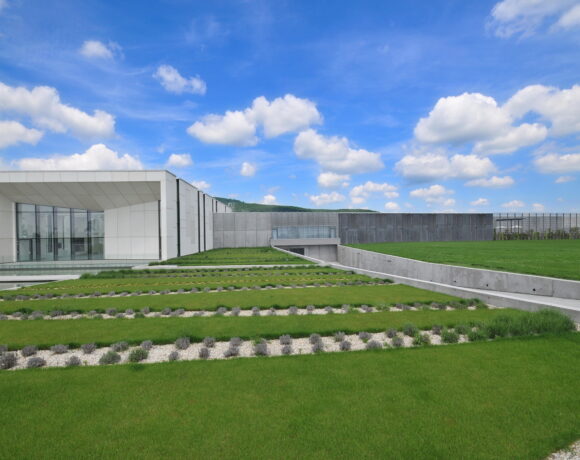The building that houses the Städtisches Museum Abteiberg, Mönchengladbach is designed by Hans Hollein. The project was started in 1972 and then ended in 1982; it is an architectural structure full of surprises both in the internal structure and in the external aspect and which, with its imaginative complexity, can compete with the most famous museum buildings. The roots of the museum, however, date back to 1904 and are linked to the foundation of an association, to the first donation of expressionist works by dr Walter Kaesbach and the permanent loan (since 1970) of the Etzold Collection. Despite a not very high budget, exceptional acquisitions followed, including works by Gerhard Richter, Sigmar Polke, Ulrich Rückriem, Mike Kelley, Franz West, Martin Kippenberger, Dieter Roth and Jonathan Meese.
Finally, in 2002, the Abteiberg sculpture garden was opened. With this, the Abteiberg Museum has finally acquired the dimension of dialogue with the outside, which can be defined as an extension of the museum directly into the urban space, overlooking the old market of Mönchengladbach.
Until May 9, the museum hosts an exhibition by Hiwa K, an eclectic artist, exile and Kurdish-Iraqi intellectual. This status of a life divided between place of origin and places of training and work has continuous repercussions in his artistic production, where he deals with existential issues and distance and integration between people who have had to make a host country their second homeland. The exhibition focuses on the theme of destruction, but the thematic outline of the exhibition itinerary is actually linked to a work that was produced for Documenta 14: “View from Above” (2017), where the cue was taken from the rubble into which Kassel was reduced in 1945, at the end of the Second World War.
On display we find, among an infinity of documents and iconic traces, also testimonies of Kurdish intellectuals in Iraq, which was a way to give voice to a “world and a people” not always listened to in the most correct and honest way, and we also say often overwhelmed by historical events and aggressions. Thus the author was able to stop the words on a more optimistic and perhaps full of illusions past, but at the same time recalling, by analogy, the years of the so-called Cold War, the Iran-Iraq War (1980-88), the two Gulf Wars. The artist, playing on the shores of parallelism and focusing on the current situation of people, connects the dimensions and places of the past with the actuality of their thinking. But take a good look, this is not a nostalgic operation, nor a stance on the defeat or suppression of rights; I would say that the right look is precisely that of having allowed the word to manifest itself, of having used the aesthetic system of the installation to create a network of reasoning that refers to other words, to a freedom of thought that is often underestimated or even vilified. The examples, in this sense, would be endless and lie in the folds of a newspaper that unfortunately never ceases to surprise us with its stupid stances or with the most retrograde behaviors that we are constantly forced to witness. We can say without fear of denial that his own education influenced his works, which are the result of constant criticism of the traditional educational system, the professionalization of art and the myth of the individual artist.
Hiwa K’s curriculum is very respectable; among others, the participation in Manifesta 7 (which in 2008 was curated by Adam Budak, Anselm Franke / Hila Peleg and Raqs Media Collective, and was organized by a large international team, managed by Hedwig Fijen, Andreas Hapkemeyer and Fabio Cavallucci ); the “Chicago Boys While We Were Singing They Were Dreaming” project for the Serpentine in London (2010); Enwezor’s invitation to the exhibition “All the World’s Futures” (Venice Biennale, 2015); the invitation to Documenta 14, in 2017. The exhibition and subsequent purchase of film documents were financed by the Ministry of Culture and Science of the State of North Rhine-Westphalia and the Hans Fries Foundation. The exhibition was curated by Susanne Titz and Haris Giannouras.
Roberto Grisancich
Info:
Hiwa K. All Cities Have Destruction In Common
11/03 – 9/05 2021
STÄDTISCHES MUSEUM ABTEIBERG
Abteistraße 27 / Johannes-Cladders-Platz
41061 Mönchengladbach
Telefono: +49 – (0) 2161-252637
mail@museum-abteiberg.de
 Hiwa K, Materie prime, 2009-2020; per gentile concessione dell’artista e KOW Berlin, vista della mostra Museum Abteiberg, 2021, ph Achim Kukulies
Hiwa K, Materie prime, 2009-2020; per gentile concessione dell’artista e KOW Berlin, vista della mostra Museum Abteiberg, 2021, ph Achim Kukulies
 Hiwa K, Materie prime, 2009-2020; per gentile concessione dell’artista e KOW Berlin, vista della mostra Museum Abteiberg, 2021, ph Achim Kukulies
Hiwa K, Materie prime, 2009-2020; per gentile concessione dell’artista e KOW Berlin, vista della mostra Museum Abteiberg, 2021, ph Achim Kukulies
 Hiwa K, This Lemon Tastes of Apple, 2011; per gentile concessione dell’artista e KOW Berlin, vista della mostra Museum Abteiberg, 2021, ph Achim Kukulies
Hiwa K, This Lemon Tastes of Apple, 2011; per gentile concessione dell’artista e KOW Berlin, vista della mostra Museum Abteiberg, 2021, ph Achim Kukulies
 Hiwa K, The Bell, 2020; per gentile concessione dell’artista, KOW Berlin e Ida Pisani, veduta della mostra Museum Abteiberg, 2021, ph Achim Kukulies
Hiwa K, The Bell, 2020; per gentile concessione dell’artista, KOW Berlin e Ida Pisani, veduta della mostra Museum Abteiberg, 2021, ph Achim Kukulies

is a contemporary art magazine since 1980






NO COMMENT